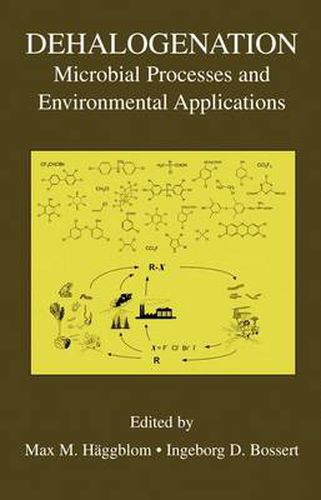Readings Newsletter
Become a Readings Member to make your shopping experience even easier.
Sign in or sign up for free!
You’re not far away from qualifying for FREE standard shipping within Australia
You’ve qualified for FREE standard shipping within Australia
The cart is loading…






This title is printed to order. This book may have been self-published. If so, we cannot guarantee the quality of the content. In the main most books will have gone through the editing process however some may not. We therefore suggest that you be aware of this before ordering this book. If in doubt check either the author or publisher’s details as we are unable to accept any returns unless they are faulty. Please contact us if you have any questions.
Halogenated organic compounds constitute one of the largest groups of environmental chemicals. The industrial production of new halogenated organic compounds has increased throughout the last century and these compounds are integral to a variety of industrial applications. Although organohalide compounds are typically considered to be anthropogenic industrial compounds, these have their counterpart in several thousands of natural biogenic and geogenic organohalides, representing most classes of organic chemicals. Natural sources account for a significant portion of the global organohalogen budget. This volume, authored by leading experts in the field, provides a current perspective on how both natural and synthetic organohalides are formed and degraded, and how these processes are incorporated into a global halogen cycle. The list of organohalides that can be utilized by microbes continues to increase dramatically, as do the number of dehalogenating microorganisms that have been identified and characterized. A critical step in the degradation of organohalides is cleavage of the carbon-halogen bond, and microorganisms have evolved a variety of metabolic strategies for dehalogenation. The chapters provide a global perspective on the diversity of dehalogenating microorganisms, explore their ecology, biochemistry and genetics, and review the range of biologically-mediated dehalogenation mechanisms. Many of the problematic organohalides, such as pesticides, chlorofluorocarbons, chlorinated solvents, polychlorinated dibenzo-p-dioxins and polychlorinated biphenyls, are covered in detail. The book provides a comprehensive overview of fate of these compounds in the environment, practical applications in the laboratory and the field, and strategies for the development of bioremediation technologies for organohalide-contaminated sites. Detailed information on biodegradation and biotransformation mechanisms for a variety of organohalides and on the microorganisms mediating these processes has greatly increased our understanding of the cycling and fate of these unique and widespread compounds in our environment. The book will serve as a comprehensive resource on the processes and applications of microbial degradation of halogenated organic compounds.
$9.00 standard shipping within Australia
FREE standard shipping within Australia for orders over $100.00
Express & International shipping calculated at checkout
Stock availability can be subject to change without notice. We recommend calling the shop or contacting our online team to check availability of low stock items. Please see our Shopping Online page for more details.
This title is printed to order. This book may have been self-published. If so, we cannot guarantee the quality of the content. In the main most books will have gone through the editing process however some may not. We therefore suggest that you be aware of this before ordering this book. If in doubt check either the author or publisher’s details as we are unable to accept any returns unless they are faulty. Please contact us if you have any questions.
Halogenated organic compounds constitute one of the largest groups of environmental chemicals. The industrial production of new halogenated organic compounds has increased throughout the last century and these compounds are integral to a variety of industrial applications. Although organohalide compounds are typically considered to be anthropogenic industrial compounds, these have their counterpart in several thousands of natural biogenic and geogenic organohalides, representing most classes of organic chemicals. Natural sources account for a significant portion of the global organohalogen budget. This volume, authored by leading experts in the field, provides a current perspective on how both natural and synthetic organohalides are formed and degraded, and how these processes are incorporated into a global halogen cycle. The list of organohalides that can be utilized by microbes continues to increase dramatically, as do the number of dehalogenating microorganisms that have been identified and characterized. A critical step in the degradation of organohalides is cleavage of the carbon-halogen bond, and microorganisms have evolved a variety of metabolic strategies for dehalogenation. The chapters provide a global perspective on the diversity of dehalogenating microorganisms, explore their ecology, biochemistry and genetics, and review the range of biologically-mediated dehalogenation mechanisms. Many of the problematic organohalides, such as pesticides, chlorofluorocarbons, chlorinated solvents, polychlorinated dibenzo-p-dioxins and polychlorinated biphenyls, are covered in detail. The book provides a comprehensive overview of fate of these compounds in the environment, practical applications in the laboratory and the field, and strategies for the development of bioremediation technologies for organohalide-contaminated sites. Detailed information on biodegradation and biotransformation mechanisms for a variety of organohalides and on the microorganisms mediating these processes has greatly increased our understanding of the cycling and fate of these unique and widespread compounds in our environment. The book will serve as a comprehensive resource on the processes and applications of microbial degradation of halogenated organic compounds.